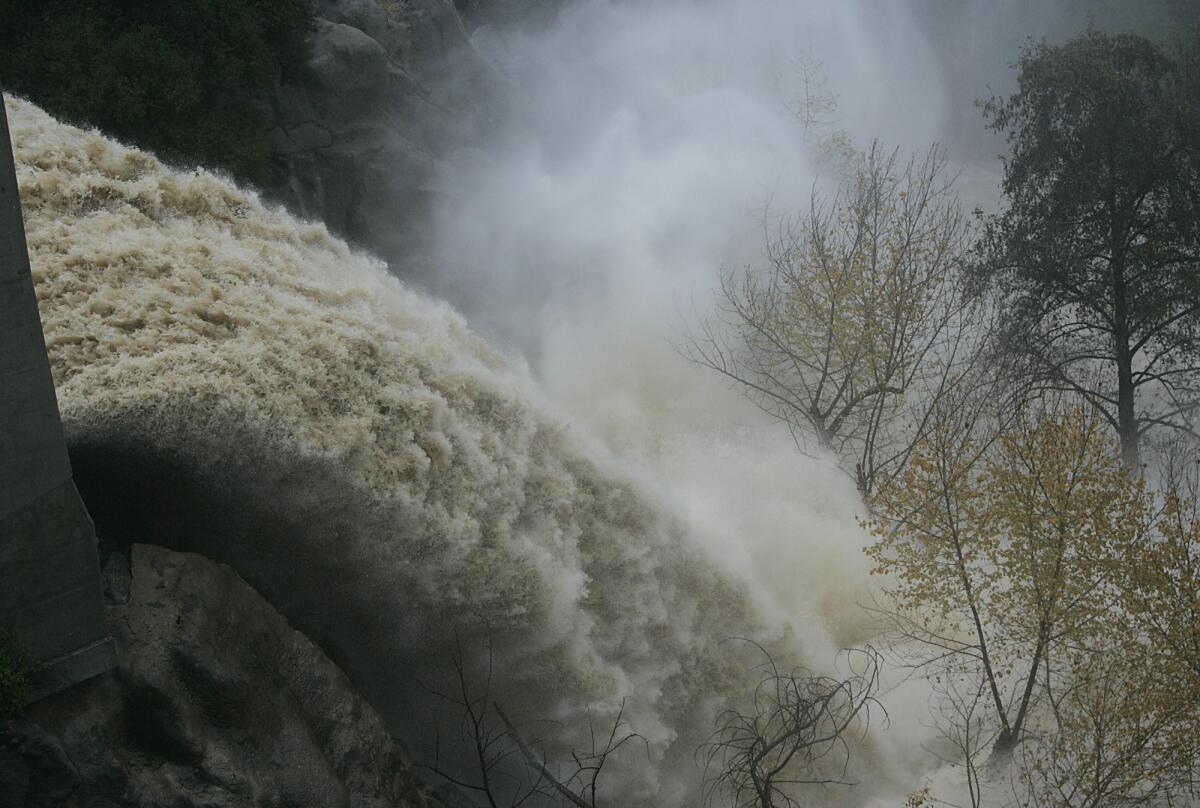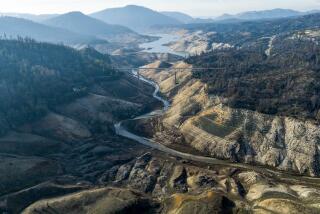With ‘Godzilla El Niño’ expected, focus shifts to Pasadena dam that could overflow

Tall trees are dwarfed by the huge and fast-moving waterfall caused by runoff from the Devil’s Gate Dam in Pasadena.
- Share via
With forecasters saying that this winter’s El Niño could be among the most powerful on record, officials preparing for the expected downpours are focusing their attention on vulnerabilities in Southern California’s flood-control system.
The National Weather Service’s Climate Prediction Center said Thursday that this El Niño is shaping up to be as strong as the El Niño that sent storms in 1997-98 that killed 17 people and caused more than $550 million in damage in California.
“This definitely has the potential of being the Godzilla El Niño,” said William Patzert, a climatologist with NASA’s Jet Propulsion Laboratory in La Cañada Flintridge.
RELATED: El Niño is coming. Are you prepared?
Los Angeles County Flood Control District officials said they have cleared debris basins and flood-control channels throughout the county — the first line of defense against mudslides — and made some improvements to dams and other infrastructure since the county’s last major rainstorms in 2004-05.
But they remain concerned about Devil’s Gate Dam in Pasadena, where debris that accumulated as a result of the Station fire has put neighborhoods downstream along the Arroyo Seco in danger of flooding.
Los Angeles County plans to remove 2.4 million cubic yards from the Hahamongna flood-control basin above Devil’s Gate Dam over the next five years. Some neighbors, outdoor recreation enthusiasts and environmentalists who oppose the project are suing to stop it.
But the sediment-removal project will not start until next year. The county has not yet awarded a contract for the work, said Keith Lilley, who oversees a group of county Department of Public Works staff who respond to storm events.
There is risk of flooding south of the dam — affecting the 110 Freeway, Pasadena, South Pasadena and northeast Los Angeles — if the San Gabriel Mountains are soaked with a series of unrelenting storms and send large amounts of mud, rocks and burned trees into a full basin, officials said.
“If we had multiple major storms with sediment, the reservoirs would fill up and we would have very little capacity for flood control and water capture,” he said.
A 2011 county report painted a grim picture of what would occur if huge rainstorms hit Devil’s Gate. Under a worst-case scenario, torrential rains could send mud, rocks and water over the dam and flooding into the Rose Bowl, South Pasadena and northeast Los Angeles in less than 40 minutes.
A subsequent report said the Rose Bowl probably wouldn’t be flooded in a single storm but could be at greater risk after a series of storms if sediment isn’t quickly removed from areas downstream from the dam.
Major sediment-removal projects are planned for other dams in Pacoima, Tujunga and three up in the San Gabriel Mountains. Those other reservoirs also have sediment buildup, but not to the same extent as Devil’s Gate.
------------
FOR THE RECORD: In the Aug. 14 Section A, an article about preparations for El Niño weather conditions said that Los Angeles County is planning a sediment removal project at a dam in Pacoima. The project is at the Pacoima Dam and Reservoir, which is in Sylmar.
------------
The Devil’s Gate work has been stalled by critics who say the operation will destroy wildlife habitat that has grown up in the basin, displace recreational activities and disrupt nearby residents with heavy truck traffic. The opponents lobbied for a smaller plan that would remove 1.4 million cubic yards of sediment.
The county has done smaller debris removal projects focused on the base of the dam to prevent the valves from being clogged.
The county is going through the design and permitting process and still has to award a contract for the larger project, Lilley said. In the meantime, he said flood-control staff will be monitoring the situation and continuing their normal maintenance of the system.
Supervisors Michael D. Antonovich and Hilda Solis will ask for a full investigation into the county’s preparedness at all county flood-control facilities, including Devil’s Gate.
Previous storms have shown vulnerability in the region’s flood-control system.
Devil’s Gate Dam was built in 1920 after devastating floods in the early 20th century, including the flood of 1914, which sent more than a dozen homes and a two-story grocery store down the arroyo.
In 2010, the year after the Station fire, an unexpectedly powerful rainstorm unleashed a torrent of mud that inundated more than 40 houses.
The power of the debris flowing off the mountain pushed a 10-ton boulder into a critical catch basin. The boulder clogged the drain like a giant stopper and the ashen muck went through the Paradise Valley neighborhood on Ocean View Boulevard. Mud flowed two miles to Foothill Boulevard.
There are several reasons scientists say El Niño is gaining strength.
First, ocean temperatures west of Peru are continuing to climb, reaching their highest level so far this year. The temperatures in a benchmark location in that area of the Pacific Ocean were 3.4 degrees above the average as of Aug. 5. That’s slightly higher than on
Aug. 6, 1997, when the readings were 3.2 degrees above normal.
Second, the trade winds that normally keep the ocean waters west of Peru cool are weakening. For this year’s El Niño to truly rival its 1997 counterpart, there still needs to be “a major collapse in trade winds from August to November as we saw in 1997,” Patzert said.
Despite the hopes for a wet winter, though, officials warned that even a monster El Niño year will almost certainly not mean an end to the drought.
In fact, it would take 2 1/2 to three times the average annual precipitation to make up for what was lost in the last four years of drought in the central Sierra, said Kevin Werner, the National Oceanic and Atmospheric Administration’s expert on climate in the western United States. That far exceeds what occurred in 1983, the wettest year on record for that region, when the area received 1.9 times the average precipitation.
“A single El Niño year is very unlikely to erase four years of drought,” Werner said.
“The drought is not ending any time soon,” added Mike Halpert, deputy director of the National Weather Service’s Climate Prediction Center.
Times Staff Writer Shelby Grad contributed to this report.
MORE ON EL NINO:
Another El Niño sign: Ocean temps hit highest level of the year
As El Nino grows, drought-stricken California braces for wild winter weather
It’s critical El Niño hits Northern California. Why experts are growing optimistic.
More to Read
Sign up for Essential California
The most important California stories and recommendations in your inbox every morning.
You may occasionally receive promotional content from the Los Angeles Times.















